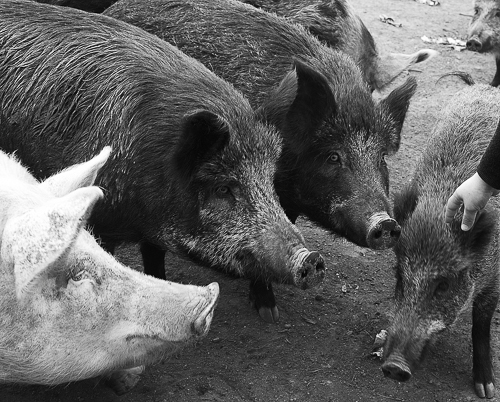The only means of sustenance of these poor families was raising pigs on their assigned properties, besides doing manual work in the countryside. Maria, who came from a village in the vicinity of Fertilia, married one of the sons of the Busi family in the 1960s. Uniting the entrepreneurial skills of her husband with her Sardinian traditional upbringing and passing these characteristics onto 4 sons, who are managing this big and modern farm, have reason to feel satisfied with the results of her husband’s and her own efforts.
Now, there are about 60 Frissona cows and one Charolais bull called Cicero at the farm. The cows are milked twice daily by means of a machine. During our visit, the cows were waiting in a line in order to be milked. When the farmer Mauro was ready, about 8 cows were allowed to enter at the same time. The milking was finished after a few minutes, then a new group of cows could enter.
The cow’s milk has a temperature of 39°C, but after having been pumped through various tubes into a big tank, the temperature is lowered about 10°C. After having milked all the cows, Tiziana, Mauro’s wife, started making a cheese called semicotto, literally half-cooked, by heating the milk up to 45°C and stirring it at the same time obtaining a thick substance called curd. After having added a small amount of rennet, in order to separate the fat and liquid parts of the curd, and after having stirred the curd until it seemed homogeneous, Tiziana extracted the fat parts from the curd and put them in small, cylindrical containers. Since they were porous, by compressing the fat parts, Tiziana was able to get rid of a large amount of the liquid parts, that is the whey. Tiiziana is also producing another type of cheese, which is called peretta, since it is pear-shaped.
The Busi family was among the first ones to sell raw milk in Sardinia, and the initiative has been met with much enthusiasm among the Sardinians. Naturally, the major part of the milk is treated in dairies before being sold in shops.
The calves are separated from their mothers shortly after being born. After the weaning, the male calves are kept in separate enclosures for some time before being slaughtered.
They are also raising pigs and wild boars at the farm. These animals live inside a large enclosure in which they can move freely. The meat is mostly for their own consumption besides a few customers.

